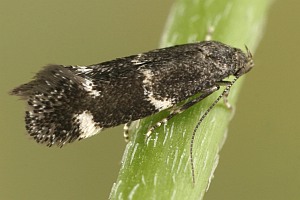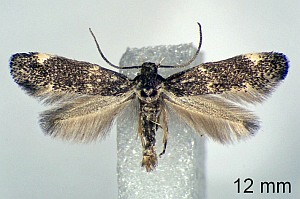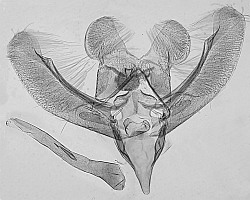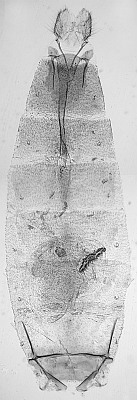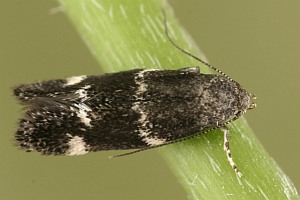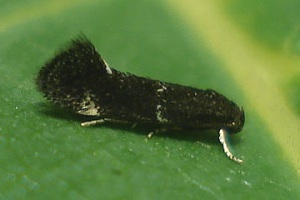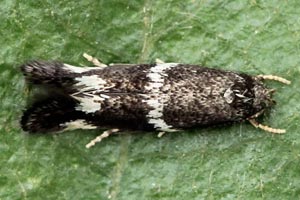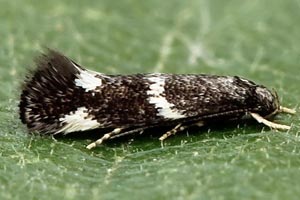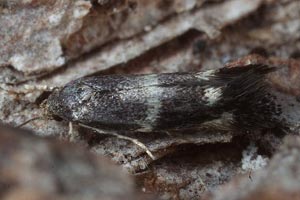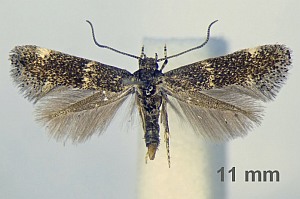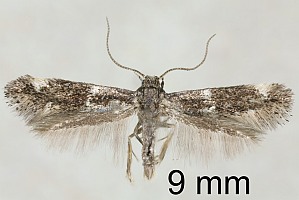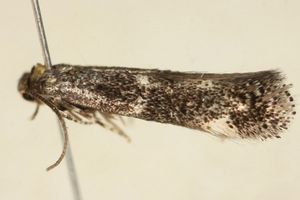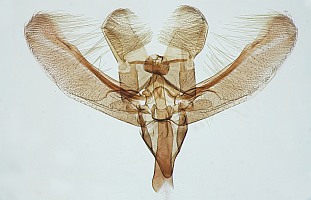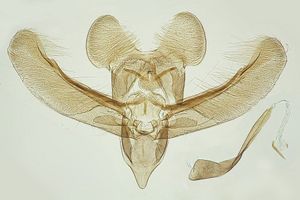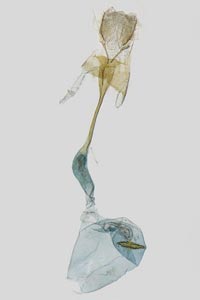

 +27Kontinente:EU
+27Kontinente:EU1. Lebendfotos
1.1. Falter
2. Diagnose
2.1. Männchen
2.2. Genitalien
2.2.1. Männchen
2.2.2. Weibchen
2.3. Erstbeschreibung
3. Weitere Informationen
3.1. Synonyme
- Microsetia exiguella Fabricius sensu Stephens, 1834
- Elachista alienella Stainton, 1851
- Elachista extensella Stainton, 1851
- Elachista zetterstedtii Wallgreen, 1852
- Elachista holdenella Stainton, 1854
- Elachista helvetica Frey, 1856
- Elachista longipennis Frey, 1885
- Elachista infamiliaris Gozmány, 1957 [synonymisiert durch Buschmann & Pastorális (2019)]
3.2. Taxonomie
Die Geschichte der Elachista infamiliaris bedarf einer näheren Erläuterung. Gozmány (1957: 134-135) beschrieb die Art auf der Basis von 2 Männchen, davon der Holotypus aus Budapest. Nach der Beschreibung äußerer Merkmale erläutert er: "Nearest to poae Stt. [...]". Er zeichnete das Genital und erläuterte dazu: "In the male genital organ (Fig. 8. D.), the uncus has the form of that of alpinella Stt.; the length of the costal fold of the valve is the same as in rufocinerea Haw; the shape of the valva resembles that of poae Stt., with its apex, however, narrower; its length corresponds to that of albifrontella Hbn."
Gaedike (1975: 245-246) studierte die beiden Typusexemplare im Naturwissenschaftlichen Museum von Budapest und zeichnete und beschrieb das Männchen-Genital neu, nahm aber keinen Vergleich mit anderen Arten vor. Kaila (2019: 76) akzeptiert die Art auf Basis dieser 2 Exemplare der Typenserie (die er aber irrtümlich als Syntypen bezeichnet, obwohl in der Erstbeschreibung klar zwischen Holotypus und Paratypus unterschieden wird).
Interessanterweise fehlt Elachista infamiliaris sowohl in der Liste von Karsholt & Razowski (1996) als auch in der Fauna Europaea. Doch warum? Vermutlich einfach deshalb, weil man L. Gozmány nicht noch einmal mit diesem Taxon konfrontieren wollte.
Doch durch die Wiederentdeckung der unterdrückten Art durch Kaila (2019: 76) sahen sich Buschmann & Pastorális (2019: 17) genötigt, jetzt doch endlich auch eine formale Synonymisierung des Taxons vorzunehmen. Sie wiesen auf eine Zeile im Katalog von Gozmány (1968: 247) hin, wo es heißt: "E. monticola WCK. (= alpinella STT. = infamiliaris GOZM.)". Gozmány (1968: 247) selbst sah in seinem 11 Jahre zuvor beschriebenen Taxon also ein Synonym, nahm allerdings keine formale Synonymisierung vor. Buschmann & Pastorális (2019) berichten darüber, dass sie von den beiden Genitalpräparaten von Gozmány im MTM Fotos anfertigten und an L. Kaila schickten - der bestimmte beide nicht als E. alpinella, sondern als Elachista atricomella, so dass E. infamiliaris jetzt als Synonym hierher zu stellen war.
Nach Kenntnisnahme der Publikation von Kaila (2019) legten wir im Lepiforum am 5. Oktober 2019 eine Artseite für E. infamiliaris an. Nach dem Studium der Arbeit von Buschmann & Pastorális (2019) wurde die Artseite am 11. Januar 2021 in eine Synonymseite umgewandelt.
3.3. Typenmaterial
Gozmány (1957: 135) teilt zum Synonym Elachista infamiliaris mit: “Holotype male : “Budapest, Farkas-völgy, 1912. V. 13, leg. Uhrik” ; paratype male : “M..... (illegible!), V. 4., leg. Krone, “nicht im K. K. Hofkabinet”. Since Krone collected in Austria and Istria (now Italy and Yugoslavia), the illegible locality name can but refer to one of the above territories. Types in the Collection of the Hungarian Natural History Museum.”
Obwohl Kaila (2019: 76) sich auf diese Originalbeschreibung beruft, gibt er an, im HNHM lägen zwei Syntypen.
(Autoren: Erwin Rennwald & Jürgen Rodeland)
3.4. Literatur
- Buschmann, F. & G. Pastorális (2019): Új fajok és változások a Magyarországon előforduló molylepke-fajok névjegyzékében (Lepidoptera). New species and changes in the checklist of the Hungarian micro-moths (Lepidoptera). — Microlepidoptera.hu, 15: 5–19. DOI: 10.24386/Microlep.2019.15.1. [PDF (ganzes Heft) auf core.ac.uk]
- Gaedike, R. (1975): Zum Status der von Rebel, Krone und Gozmány beschriebenen Elachista-Arten. — Annales Historico-Naturales Musei Nationalis Hungarici 65: 239-248 [PDF auf publication.nhmus.hu].
- Beschreibung als Elachista infamiliaris: Gozmány, L. (1957): Notes on the generic group Stomopteryx Hein., and the descriptions of some new microlepidoptera. — Acta zoologica Academiae Scientiarum Hungaricae 3 (1-2): 107-135. [Digitalisat auf archive.org]
- Gozmány, L. (1968): Hazai molylepkéink magyar nevei. — Folia Entomologica Hungarica, 21 (17): 225–296. [PDF auf publication.nhmus.hu]
- Kaila, L. (2019): An annotated catalogue of Elachistinae of the World (Lepidoptera: Gelechioidea: Elachistidae). — Zootaxa 4632 (1): 1-231. [PDF (open access) auf mapress.com]
- SCHÜTZE (1931): 21 und 22
- Erstbeschreibung: Stainton, H. T. (1849): An attempt at a systematic catalogue of the British Tineidæ & Pterophoridæ: I-IV, 1-32. London (John van Voorst).
- Stainton, H. T. (1858): The natural history of the Tineina 3: I-IX, 1-269, Elachista pl. I-VII, Tischeria pl. I. London (John van Voorst) – Paris (Deyrolle) – Berlin (E. S. Mittler und Sohn). — Digitalisat auf archive.org: [34-45], [Elachista pl. I fig. 1].



























